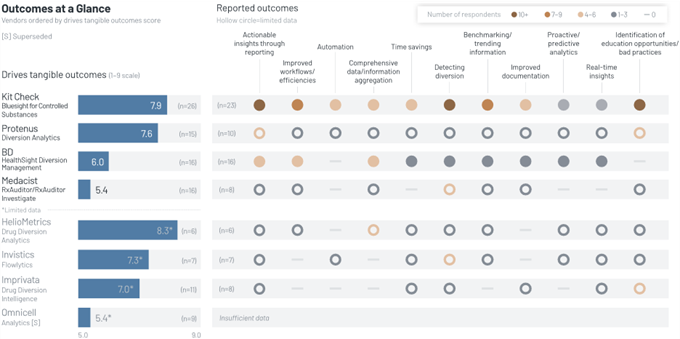
New Possibilities in Drug Diversion Monitoring
Though the COVID-19 pandemic has been a major focus for the past few years, drug diversion is still a pressing problem for healthcare organizations. This can potentially involve lawsuits, federal fines, and the loss of expensive drugs. Many provider organizations are currently managing this issue by using drug diversion monitoring solutions.
Drug diversion monitoring is a relatively newer segment for KLAS, but there are even more vendors and solutions available now than when we first started. As more vendors have entered this space, there have been tons of energy and new adoption. We talk about many more vendors in our recent Drug Diversion Monitoring 2022 report than we could previously because there has been so much more recent adoption of these newer tools.
A Peek at Vendor Performance
The good news is that most organizations using these solutions are seeing an impact and getting positive outcomes. You can see this in the below chart that shows the reported outcomes, where the feedback pinpoints specific outcomes for each vendor. Most people that we talked to are getting actionable insights through the reporting capabilities of their tool.
That said, some vendors are more consistent than others, and when you read the report, that becomes clearer. It is also important to note that Medacist and Omnicell both have old technology that is not go-forward technology. Medacist’s legacy product RxAuditor is not go-forward technology, while RxAuditor Investigate is.

Some Outcomes Being Realized
These solutions are intended to help healthcare organizations prevent safety and compliance problems caused by drug diversion, like staff taking controlled substances for their own use or selling them to others. In addition, organizations lose a lot of money on diverted drugs and on the potential legal costs of unaddressed diversion. These may be the most obvious reasons, but the solutions are also meant to track clinicians' utilization of controlled substances and audit for best practices with the goal of reducing drugs wasted and preventing malicious diversion.
It is telling that one of the most common outcomes providers mention is that they are better able to monitor for compliance with drug utilization protocols. Essentially, the technology is truly helping organizations to see whether and where their staff uses too many drugs. The healthcare organizations using these solutions can then decide how to take other corrective action. In many instances, organizations are catching diverters using almost any vendor’s technology, with the exception of Omnicell’s sunsetted technology.
One outcome we’re seeing that isn’t as prominent in the report is that by using drug diversion monitoring solutions, providers now have a way to implement an actual process around handling drug diversion cases. Organizations are putting in an operational structure to regularly monitor their data, assign which department and team leads will lead the investigation or interventions, and then follow up on the progress of the actions taken.
A Note on Infusion Pump Integration
When it comes to pump integration, there are some important things to know. During our research, providers frequently mentioned wanting to have their drug diversion solution integrated with their infusion pumps. In order to make pump data usable in a diversion investigation, providers need to be able to tie the pump to a patient and from that patient, they need to tie the pump to specific staff. Today, the only way to associate pump data to patient is through implementing bidirectional pump-EMR interoperability.
If your organization isn't live with pump-EMR interoperability, then the pump data will lack the context needed to make it useful in a diversion investigation. Approximately fewer than 15% of US organizations are integrated between their smart pump and their EMR today. So, making that integration right now is just not as usable or beneficial as a lot of people like to hope.
Important Takeaways
The insights in KLAS’ recent report will be especially helpful for those who are looking for a new solution or are looking to understand what they can expect with a new solution. In general, the data shows what these next-generation systems are able to do along with some of the common issues that providers have had. For instance, the guidance and support provided by most of the vendors could be improved. We recommend reading the full report to become more aware of these and other challenges as well as ways to get to desired outcomes.
Photo Credit: Yakobchuk Olena, Adobe Stock